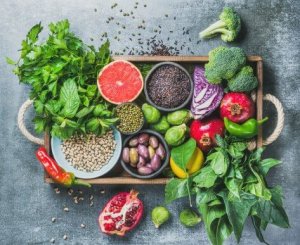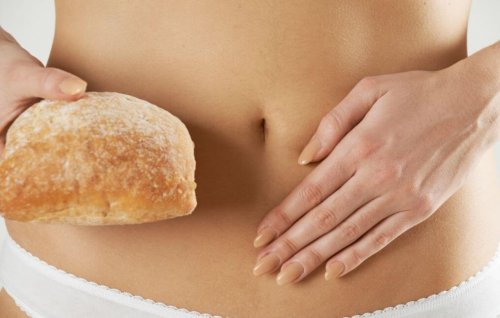How to Improve a Gluten-Free Diet

Success in improving a gluten-free diet is a matter of paying attention. It’s about maintaining a healthy diet without contraindicated ingredients. This applies to people with celiac disease, wheat allergies, or sensitivity to non-celiac gluten. Some people also follow a gluten-free diet to lose weight.
Gluten is a protein that’s present in much of the food we consume at breakfast or dinner. Foods that consist of wheat, barley, oats, rye, or spelt contain gluten to a greater or lesser degree. We can also find it in starch, pasta, bread, or flour. Some medications, supplements, and vitamins also include gluten.
Celiac disease
There’s no cure for celiac disease, but it can be controlled. It affects the immune systems of the one percent of the world’s population who suffer damage in the small intestine when they ingest gluten.
This affliction occurs in the form of abdominal pain, diarrhea, depression, or a sense of irritation. It’s genetic and we can detect it through blood tests or a biopsy of the small intestine’s tissue.
When people who suffer from this condition consume gluten, it deteriorates the mucosa of the intestine and produces inflammation. As a result, the absorption of essential nutrients decreases with a serious risk of nutritional deficiency.
The only treatment for celiac disease is a gluten-free diet. Not doing it increases the chances of complications taking place, such as autoimmune disorders or iron -deficiency anemia. It also decreases bone density and causes a lack of folate and vitamin B12.
Simultaneously, unwanted weight loss usually occurs. If a person doesn’t follow proper treatment, various types of cancer may appear in the intestine or colon.
Sensitivity to non-celiac gluten and wheat allergy
A gluten-free diet is also a solution for non-celiac gluten sensitivity and wheat allergy. People often use it for losing weight, although the health consequences can be negative.

Gluten intolerance
In children, intolerance to the gluten protein occurs in the form of swelling, gas, stomach pain, diarrhea, or nausea. There are also irregularities in weight and growth.
In adults, the effects are less invasive: mild diarrhea, anemia, weight loss, and constipation. A person may feel fatigue or emotional distress, anguish, irritation, discouragement, or depression. Other manifestations are bruising, nosebleeds, hair loss, the absence of menstruation, cramps, or ulcers in the mouth.
Gluten-free foods
To start a gluten-free diet, you must first be sure that you have celiac disease. This is analyzed through an intestinal biopsy. If the results are positive, you must follow a gluten-free diet throughout your life since a small portion of that protein will cause intestinal villi lesions.
It’s essential to learn to live with this situation and to know which foods don’t contain gluten. Your supermarket cart should carry veal or pork meats, poultry, fish, shellfish, and eggs. You will also have to buy fresh, frozen, and packaged fruits and vegetables.
Among other alternatives, dairy products, ice cream and sorbets, and frozen waffles should also be part of your weekly menu to avoid ingredients with traces of gluten.
When buying spices, it’s advisable to read the labels and know how to choose them. In the supermarket, you will find them refined and well packed; this doesn’t mean they don’t have gluten. You can also buy ground or dehydrated spices. The important point is that the package specifies the term “gluten-free”.
On the other hand, it’s necessary to avoid pates, sausages, cheeses that are melted, grated, or sliced, and canned meat or fish; especially if they have sauces. The same applies to chocolate, cocoa, sauces, coffee substitutes, roasted or fried nuts, candies, ice cream, and sweets. All of these foods pose a risk for coeliacs.

Good options for a gluten-free diet
Corn tortillas, jelly, popcorn, cookies, rice cakes, nuts, and seeds are excellent choices. Other equally ideal products are rice creams, corn grits, rice flakes, brown or white rice, and some corn chips.
Other foods you can include are jams, honey, corn or potato starch, peanut butter, molasses, and brown, white, or icing sugar. Additionally, spices and herbs, pepper, sauces, salt, pickles, mustard, distilled vinegar, and most salad dressings can’t be missing from your diet.
The experts give a period between six months and two years to achieve success with the gluten-free diet based treatment. Everything will depend on the condition of the patient and the periodic monitoring being maintained over the progression of the results.
Success in improving a gluten-free diet is a matter of paying attention. It’s about maintaining a healthy diet without contraindicated ingredients. This applies to people with celiac disease, wheat allergies, or sensitivity to non-celiac gluten. Some people also follow a gluten-free diet to lose weight.
Gluten is a protein that’s present in much of the food we consume at breakfast or dinner. Foods that consist of wheat, barley, oats, rye, or spelt contain gluten to a greater or lesser degree. We can also find it in starch, pasta, bread, or flour. Some medications, supplements, and vitamins also include gluten.
Celiac disease
There’s no cure for celiac disease, but it can be controlled. It affects the immune systems of the one percent of the world’s population who suffer damage in the small intestine when they ingest gluten.
This affliction occurs in the form of abdominal pain, diarrhea, depression, or a sense of irritation. It’s genetic and we can detect it through blood tests or a biopsy of the small intestine’s tissue.
When people who suffer from this condition consume gluten, it deteriorates the mucosa of the intestine and produces inflammation. As a result, the absorption of essential nutrients decreases with a serious risk of nutritional deficiency.
The only treatment for celiac disease is a gluten-free diet. Not doing it increases the chances of complications taking place, such as autoimmune disorders or iron -deficiency anemia. It also decreases bone density and causes a lack of folate and vitamin B12.
Simultaneously, unwanted weight loss usually occurs. If a person doesn’t follow proper treatment, various types of cancer may appear in the intestine or colon.
Sensitivity to non-celiac gluten and wheat allergy
A gluten-free diet is also a solution for non-celiac gluten sensitivity and wheat allergy. People often use it for losing weight, although the health consequences can be negative.

Gluten intolerance
In children, intolerance to the gluten protein occurs in the form of swelling, gas, stomach pain, diarrhea, or nausea. There are also irregularities in weight and growth.
In adults, the effects are less invasive: mild diarrhea, anemia, weight loss, and constipation. A person may feel fatigue or emotional distress, anguish, irritation, discouragement, or depression. Other manifestations are bruising, nosebleeds, hair loss, the absence of menstruation, cramps, or ulcers in the mouth.
Gluten-free foods
To start a gluten-free diet, you must first be sure that you have celiac disease. This is analyzed through an intestinal biopsy. If the results are positive, you must follow a gluten-free diet throughout your life since a small portion of that protein will cause intestinal villi lesions.
It’s essential to learn to live with this situation and to know which foods don’t contain gluten. Your supermarket cart should carry veal or pork meats, poultry, fish, shellfish, and eggs. You will also have to buy fresh, frozen, and packaged fruits and vegetables.
Among other alternatives, dairy products, ice cream and sorbets, and frozen waffles should also be part of your weekly menu to avoid ingredients with traces of gluten.
When buying spices, it’s advisable to read the labels and know how to choose them. In the supermarket, you will find them refined and well packed; this doesn’t mean they don’t have gluten. You can also buy ground or dehydrated spices. The important point is that the package specifies the term “gluten-free”.
On the other hand, it’s necessary to avoid pates, sausages, cheeses that are melted, grated, or sliced, and canned meat or fish; especially if they have sauces. The same applies to chocolate, cocoa, sauces, coffee substitutes, roasted or fried nuts, candies, ice cream, and sweets. All of these foods pose a risk for coeliacs.

Good options for a gluten-free diet
Corn tortillas, jelly, popcorn, cookies, rice cakes, nuts, and seeds are excellent choices. Other equally ideal products are rice creams, corn grits, rice flakes, brown or white rice, and some corn chips.
Other foods you can include are jams, honey, corn or potato starch, peanut butter, molasses, and brown, white, or icing sugar. Additionally, spices and herbs, pepper, sauces, salt, pickles, mustard, distilled vinegar, and most salad dressings can’t be missing from your diet.
The experts give a period between six months and two years to achieve success with the gluten-free diet based treatment. Everything will depend on the condition of the patient and the periodic monitoring being maintained over the progression of the results.
All cited sources were thoroughly reviewed by our team to ensure their quality, reliability, currency, and validity. The bibliography of this article was considered reliable and of academic or scientific accuracy.
- Asociación Celíaca de Cataluña. Tabla orientativa de alimentos con y sin gluten. Extraído de: https://www.celiacscatalunya.org/pdfs/apto_no_apto.pdf
- Sociedad Española de Cardiología. Dieta para la intolerancia al gluten. Extraído de: https://fundaciondelcorazon.com/images/stories/file/dieta_intolerancia_gluten_celiacos.pdf
- Gluten Intolerance Group. 2017. Deficiencias Nutricionales y la Dieta sin Gluten. Extraído de: https://gluten.org/wp-content/uploads/2015/06/EDU_NtrntDfcncs_Spanish.pdf
This text is provided for informational purposes only and does not replace consultation with a professional. If in doubt, consult your specialist.








